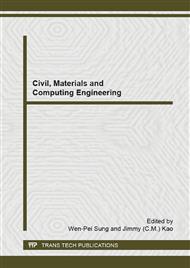[1]
B.K. Walsh, K. Hood and G. Merritt: Pediatric Airway Maintenance and Clearance in the Acute Care Setting: How To Stay Out of Trouble. Respiratory Care. Vol. 56 NO. 9 (2011), pp.1424-1444.
DOI: 10.4187/respcare.01323
Google Scholar
[2]
C. Giannantonio, P. Papacci, R. Ciarniello, M.G. Tesfagabir, V. Purcaro, F. Cota, C.M. Semeraro and C. Romagnoli: Chest physiotherapy in preterm infants with lung diseases. Italian Journal of Pediatrics. Vol. 36 NO. 65 (2010), pp.1-5.
DOI: 10.1186/1824-7288-36-65
Google Scholar
[3]
Y.H. Lin: Nursing Experience of a Preschooler with Acute Bronchitis. Yuan-Yuan Nursing. Vol. 4 NO. 1 (2010), pp.52-59.
Google Scholar
[4]
M. McIlwaine: Chest physical therapy, breathing techniques and exercise in children with CF. Paediatric Respiratory Reviews. Vol. 8 (2007), pp.8-16.
DOI: 10.1016/j.prrv.2007.02.013
Google Scholar
[5]
S.L. Barnhart and M.P. Czervinske: Perinatal and pediatric respiratory care (W. B. Saunders Company, London 1995), pp.228-230.
Google Scholar
[6]
W.E. Hammon, D.R. McCaffree and A.J. Cucchiara: A Comparison of Manual to Mechanical Chest Percussion for Clearance of Alveolar Material in Patients With Pulmonary Alveolar Proteinosis (Phospholipidosis). Chest. Vol. 103 NO. 5 (1993).
DOI: 10.1378/chest.103.5.1409
Google Scholar
[7]
R.S. Dos Santos, M.V. Donadio, G.V. da Silva, C.N. Blattner, D.A. Melo, F.B. Nunes, F.S. Dias, E.D. Squizani, L. Pedrazza, I. Gadegast, J.R. de Oliveira: Immediate Effects of Chest Physiotherapy on Hemodynamic, Metabolic, and Oxidative Stress Parameters in Subjects With Septic Shock. Respiratory Care. Vol. 59 NO. 9 (2014).
DOI: 10.4187/respcare.02859
Google Scholar
[8]
G.T. Wang, F.Y. Li, J. Li and S.Z. Liou: Influence of chest vibrating sputum evacuation apparatus on postoperative expectoration in patients with pulmonary lobectomy. Journal of Clinical Medicine in Practice. Vol. 17 No. 10 (2013), pp.55-57.
Google Scholar
[9]
I. Bukhman: TRIZ Technology for Innovation (Cubic Creativity Company, Taipei 2012).
Google Scholar
[10]
T.L. Liu, T.C. She: Application of systematized innovation process-Take office chairs as an example. Vanung Commercial Journal. Vol. 14 (2009), pp.259-276.
Google Scholar
[11]
I. M. Ilevbare, D. Probert and R. Phaal: A review of TRIZ and its benefits and challenges in practice. Technovation. Vol. 33 NO. 2 (2013), pp.30-37.
DOI: 10.1016/j.technovation.2012.11.003
Google Scholar
[12]
Y.C. Zhou: Contradiction theory and application of TRIZ. Science and Management. Vol. 3 (2010), pp.15-18.
Google Scholar
[13]
J. Yoon and K. Kim: An automated method for identifying TRIZ evolution trends from patents. Expert Systems With Applications. Vol. 38 NO. 12 (2011), pp.15540-15548.
DOI: 10.1016/j.eswa.2011.06.005
Google Scholar


